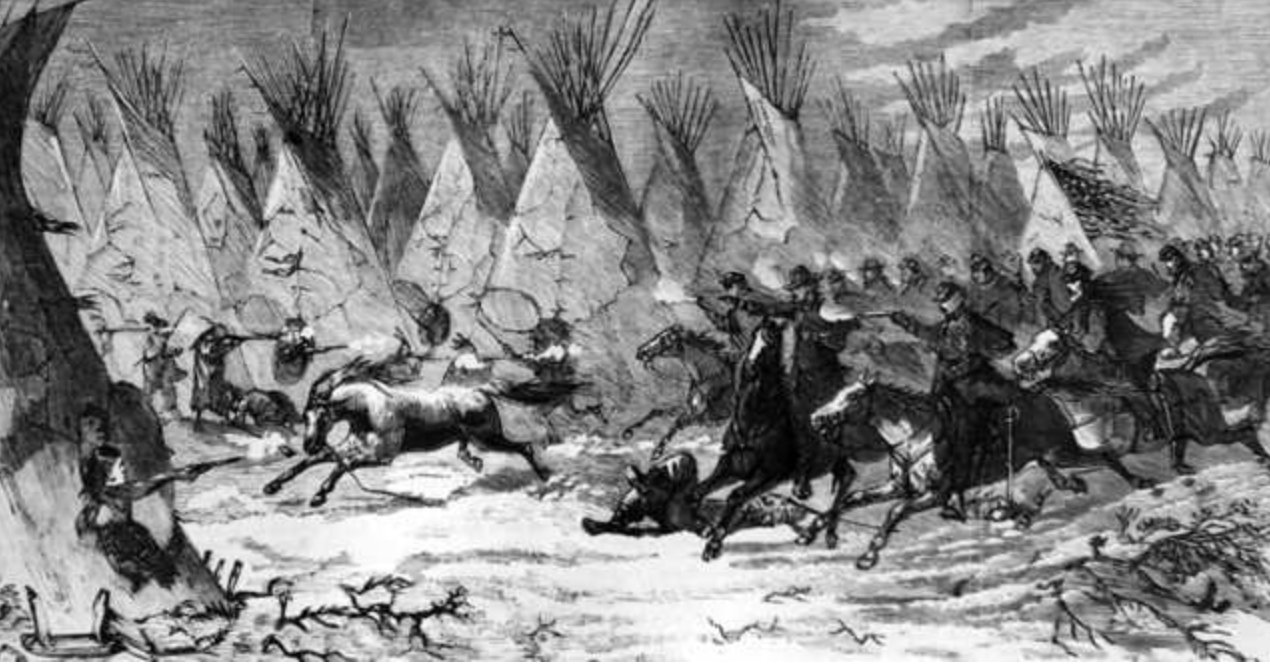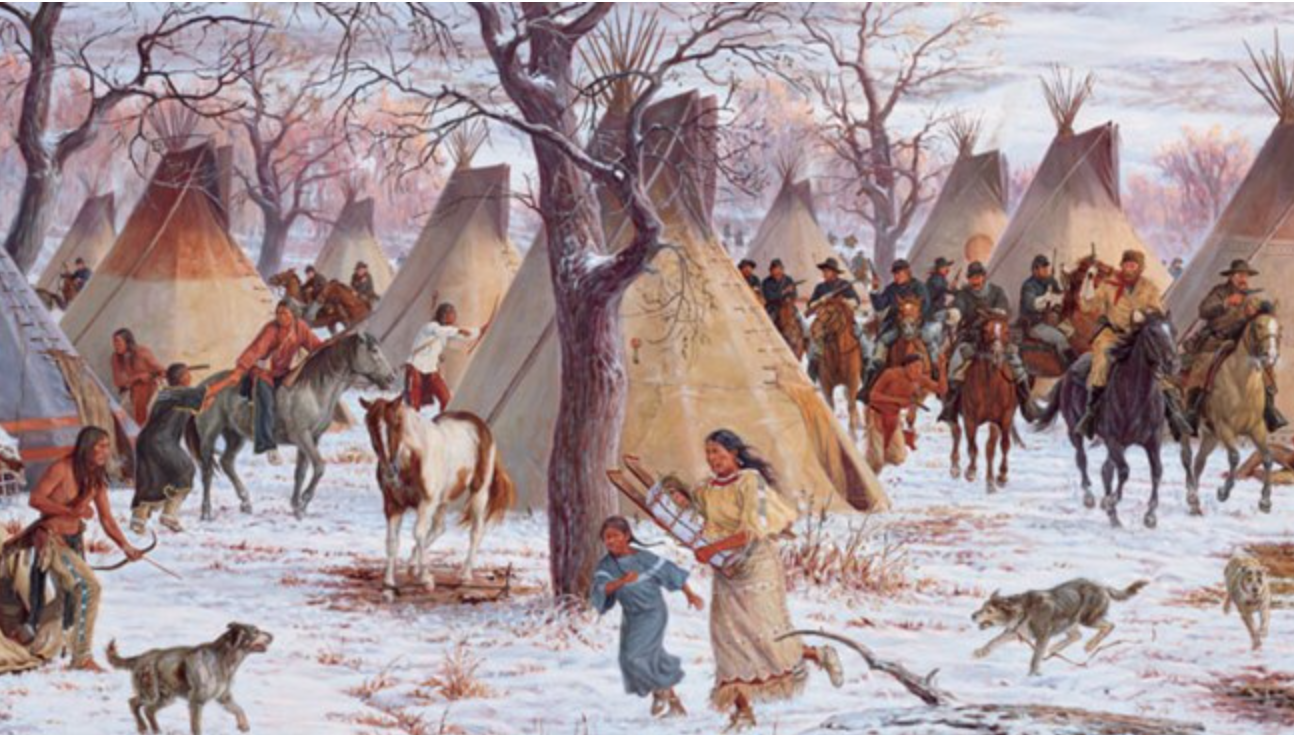Summary
In this lesson, students will begin by analyzing two images depicting the Washita Massacre to generate hypotheses about what happened during this historical event. Next, students will read and analyze an article and complete a corresponding history frame graphic organizer. As an extension, students will examine the text of a historical marker at the Washita Battlefield NHS, and they will determine why a growing number of historians think the event should be labeled a “massacre” rather than a "battle." Students will demonstrate what they have learned by creating a caption for one of the images that they viewed at the beginning of the lesson.
Essential Question(s)
Why was the Washita Massacre significant?
Snapshot
Engage
Students analyze two images of the massacre during an I Notice, I Wonder activity, and they hypothesize about what had happened.
Explore
Students read and analyze an article about the Washita Massacre.
Explain
Students use their article analysis to complete a History Frame.
Extend
Students examine the text of a historical marker at the Washita Battlefield NHS and determine why a growing number of historians think the event should be labeled a “massacre” rather than a “battle.”
Evaluate
Students create a caption for one of the images that they viewed at the beginning of the lesson to demonstrate what they have learned.
Materials
Lesson Slides (attached)
I Notice, I Wonder Chart (attached; one per student)
Student Reading (attached; one per student)
Student Reading with Teacher's Notes (attached)
History Frame (attached; one per student)
History Frame with Teacher's Notes (attached)
Historical Marker Transcript handout (attached; one per student)
Historical Marker Questions handout (attached; one per group)
Student devices with Internet access (optional)
Engage
15 Minute(s)
Use the attached Lesson Slides to guide the lesson. Display slide 3, and begin by organizing students into groups of four. Students will engage in a modified Think, Pair, Share activity. For this activity, the "Think" portion will involve completing an I Notice, I Wonder chart.
Give each student a copy of the attached I Notice, I Wonder chart. Tell students that they will view two different images of the same historical event and record at least one thing they "notice" (something that they see in the images) and at least one thing they "wonder" (questions they have based on what they see in the images) about each image.
Display slide 4 to reveal the first image, “The Seventh U.S. Cavalry Charging Into Black Kettle's Village at Daylight” (pictured below). Give students a few minutes to record their responses individually in the I Notice, I Wonder Chart.

Display slide 5 to reveal the second image, “The 1868 Battle of the Washita” (pictured below), by Steven Lang. Again, give students a few minutes to record their responses individually in the I Notice, I Wonder Chart.

Return to the first image on slide 4. Invite students to "pair" with one or two other students to discuss the things that they noticed and wondered about the image. Students should add to their I Notice, I Wonder charts based on their conversations with their peers. Once students have had a few minutes to discuss, ask student groups to choose one or two responses to “share” out with the whole class. When you feel that enough has been said about the first image, move to slide 5 to display the second image, and repeat the pair-and-share process.
Display slide 6. Ask students to return to their groups and discuss the question on the slide: What do you think is happening in these images? Using your prior knowledge and evidence from the images, justify your response. Explain to students that their answer does not have to be correct, but it should be a well-reasoned hypothesis based on their prior knowledge and what they observed in the images. Invite groups to share out their hypotheses. Conclude the discussion by noting that the images depict the massacre of the Cheyenne that took place at the Washita River in Indian Territory (now Oklahoma) in the autumn of 1868.
Display slide 7, and explain to students that throughout the lesson, they will be exploring the following essential question: “Why was the Washita Massacre significant?" Additionally, display slide 8 to review the learning objectives for this lesson.
Explore
25 Minute(s)
Display slide 9. To explore the essential questions and learning objectives, explain to students that they will begin by working with groups of four to read and analyze an article about the Washita Massacre. Students will be using a modified version of the POMS: Point of Most Significance strategy to help with their analysis of the text. After reading each section, students will work with their group to identify a point of most significance. Thus, by the end of the reading, they will have developed a total of four POMS statements to summarize the most significant information from each section of the text.
Distribute copies of the attached Student Reading handout. Ask students to read through section 1 (the first three paragraphs) with their groups. Give groups approximately five minutes to discuss what they think the POMS is for that section, but tell them not to write anything down yet—instead, have them prepare to share their ideas with the class. Call on several groups to share their ideas. Once you have heard from the groups, synthesize the various contributions to craft the first POMS as a class. Have students write down the statement that you craft for POMS 1.
Allow groups time to work through the remaining three sections of the article, instructing them to stop at the end of each section to document a POMS.
When groups have wrapped up their reading, assign each group one of the POMS (2–4) to share with the whole class. As groups share their responses, clarify any missing or inaccurate information, and encourage students to modify their responses based on the whole-class discussion.
Explain
25 Minute(s)
Display slide 10, and pass out a copy of the attached History Frame to each student. Still working with their groups, students should use the information from the article and the POMS activity to respond to the prompts in the History Frame graphic organizer.
Once groups have completed the history frame, assign each group a different part of the graphic organizer to share out. You might consider grouping together the Participants/Key Players, When, and Where sections, asking one group to share all three, as those are the "easy" sections. You might also ask several groups to share one or two items from the Causes/Conflicts section or from the Effects/Resolution section, as there should be more than one answer in those sections. The goal is to generate a class discussion where information that belongs in the graphic organizer is shared, confirmed, synthesized, and modified if needed.
Extend
25 Minute(s)
Move to slide 11 and have students view the photo of the historical marker, “The Battle of the Washita.” Pass out to each student the Historical Marker Transcript handout, which includes the transcribed text from the marker.
Display slide 12. Arrange your students into groups of three. Using the Jigsaw strategy, make sure that every student in each group is reading a different couple of paragraphs than their partner. Ask the students to number off from 1-3 and have them read the section of the text that corresponds with their number. This will ensure that the paragraphs are split equally among the three students in each group. Give the students about five minutes to read their assigned paragraphs.
Display slide 13. Make sure to take time to go over the definitions of “battle” and “massacre.” Be sure that students have a good understanding of each definition. For example, the word “indiscriminate” is important to emphasize, but you may need to define that word for some of the students as well. Consider asking volunteers whether they want to add anything to the provided definitions.
Pass out the attached Historical Marker Questions handouts to each small group. Make sure to keep slide 13 displayed and have the groups work together for about 15 minutes to answer the questions included on the bottom of their handouts:
What are some details that stood out to you in the text?
How many Cheyenne men, women, and children were killed on the morning of November 27, 1868? How many soldiers in the 7th Cavalry were killed?
What information do you think might have been left out of the text?
Based on the text and what you already know, why do you think many historians now agree that this was a massacre, and not a battle?
Once students have answered the questions, call on a volunteer from one of the groups, and have them share their group’s answer to the first question. Repeat this process with the other questions, making sure to call on a volunteer from a different group for each question.
Evaluate
10 Minute(s)
Display slide 14. Invite students to choose one of the two images from the beginning of the lesson (which are also repeated on slides 15 and 16). Using the Caption This strategy, ask students to create a caption showcasing what they have learned about the Washita Massacre. Captions should be between 1-3 sentences, and students should incorporate what they have learned about the massacre to explain what is happening in the image.
Resources
Carter, G. D. (2023, February 7). The Battle of the Washita: 1868. Historical Marker Database. https://www.hmdb.org/m.asp?m=11468
Conn, J. S. (2007, October 16). The Battle of the Washita marker. Historical Marker Database. https://www.hmdb.org/PhotoFullSize.asp?PhotoID=35923
K20 Center. (n.d.). Caption this. Strategies. https://learn.k20center.ou.edu/strategy/82
K20 Center. (n.d.). Google classroom. Tech Tools. https://learn.k20center.ou.edu/tech-tool/628
K20 Center. (n.d.). I notice, I wonder. Strategies. https://learn.k20center.ou.edu/strategy/180
K20 Center. (n.d.). Jigsaw. Strategies. https://learn.k20center.ou.edu/strategy/179
K20 Center. (n.d.). Padlet. Tech Tools. https://learn.k20center.ou.edu/tech-tool/1077
K20 Center. (n.d.). POMS: Point of most significance. Strategies. https://learn.k20center.ou.edu/strategy/101
K20 Center. (n.d.). Think-pair-share. Strategies. https://learn.k20center.ou.edu/strategy/139
Lang, S. (2003). The 1868 battle of the Washita [Image]. National Park Service. https://www.nps.gov/waba/learn/historyculture/index.htm.
Unknown artist. (1868, December 19). The Seventh U.S. Cavalry charging into Black Kettle’s village at daylight, Nov. 27, 1868 [Image]. Harper’s Weekly. Library of Congress. https://www.loc.gov/item/96521161/


